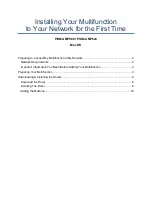
XEROX WorkCentre 7755/7765/7775 Information Assurance Disclosure Paper
23
Ver. 1.01, April 2010
Page
23 of 40
3.4.2.
Alternate Boot via Network Controller Serial Port
Alternate Boot (Alt-boot) is a means for the Portable Service Workstation (PSW) to directly connect to the
Network Controller. The primary purpose of Alternate Boot is to provide the capability to boot the Network
Controller in case of hard disk failure, to perform system diagnostics, and load Network Controller software,
independent of other sub-systems.
To enter this mode a user must strike any key on the PSW within 10 seconds of power on. If the 10 seconds
times out, then the normal boot sequence occurs and the serial port acts as a typical tty (see next section).
However, if this mode is entered, a Xerox unique serial protocol is used to communicate to the alt-boot
code. All commands are DOS-type menu driven (i.e. type in a number to start a command). If a PSW is
connected, the application on the PSW cannot be accessed without logging on with a password (see next
section).
If the PSW is used and is successfully logged on, then the Ethernet port is used to download executable
files. The serial port is used for commands and status. Again, please refer to the PSW section for details.
3.4.3.
tty Mode
When the Network Controller has completed booting a login line will be displayed. This mode is a typical
tty window, and is password protected. This password changes with each major software release. The
password is stored on the Network Controller hard disk in an encrypted format similarly to how UNIX
encrypts and stores passwords. Through this port a user can gain information and access to any files or
information stored in the Network Controller DRAM or Network Controller hard disk. However, this mode is
only used by a CSE if directed by a Field Engineer when all other diagnostics fail to solve a problem. The
written repair procedures that direct the CSE never employ this mode.
3.4.4.
Diagnostics via Portable Service Workstation (PSW) Port
When connected to the PSW Port, the PSW provides an extensive suite of diagnostic functions for use by
the Xerox Customer Service Engineer (CSE). The over-the-wire protocol is Xerox proprietary. This port
cannot process any other protocol except this proprietary protocol used for machine diagnosis. Also, the
PSW must have an application loaded to connect to and communicate with the device.
Customer documents or files cannot be accessed during a diagnostic session, nor are network servers
accessible through this port.
3.4.4.1.
Access
The Xerox Service Technician must be authenticated twice:
1.
The first password, called the
PSW Lock Facility,
is obtained by calling a Xerox service location
and providing the CSE employee number and the serial number of the PSW. The password is
then given to the Xerox Service Technician, and is valid for 90 days. When the password
expires, the Xerox Service Technician must call in again. This password is unique to the client
application running on that particular PSW, and is required to log onto the PSW prior to
initiating communications with the machine.
2.
Once the application is running, the PSW supplies the second password (different from the
first) to authenticate the session to the device. This embedded password is automatically
passed from the application to the machine, and is never seen by anyone. It is hardcoded in
the software of the Marking Engine and the PSW application, and is common to all products. It
is not encrypted. Many of the diagnostic routines will require this password in order to
function.
3.4.4.2.
Communication Protocol
















































